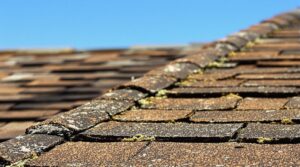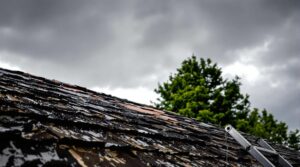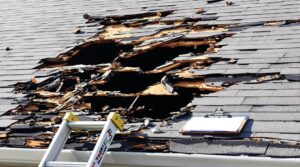Wondering how a fresh roof makeover affects your insurance situation? Let's dive in!
Think of your roof as a protective helmet for your home – the newer and sturdier it is, the more insurance companies will love you. Installing a new roof isn't just about curb appeal; it's your ticket to potentially slashing those pesky insurance premiums by 10-20%. Pretty sweet deal, right?
But here's where it gets even more interesting: upgrading to premium materials can be your secret weapon for maximizing savings. Got your eye on metal, slate, or those fancy impact-resistant shingles? Smart move! These top-tier options could land you additional discounts ranging from 5-35%, depending on your provider.
Your location plays a starring role too. Living in hurricane alley? Your insurance company might have different requirements than someone in a mild climate zone. Local building codes, weather patterns, and regional risks all influence how insurers view your new roof investment.
Pro tip: Partner with a public adjuster and keep detailed records of your roof upgrade. Think of it as creating a paper trail that proves your home's enhanced protection level. This documentation becomes your best friend when filing claims or negotiating better rates.
Remember: a new roof isn't just an expense – it's an investment in your home's safety and your wallet's happiness. Insurance companies reward proactive homeowners who prioritize protection, and that's exactly what a new roof represents.
Key Takeaways
Want to Know How a New Roof Can Be Your Insurance's Best Friend?
Think of your roof as a protective shield – the better it is, the more your insurance company will love you! Let's break down why upgrading your roof is a smart money move:
Insurance Savings That'll Make You Smile
Just like a safer car gets you better auto insurance rates, a new roof can slash your home insurance premiums. Why? Because you're basically giving your home a sturdy helmet against Mother Nature's mood swings!
Smart Material Choices = Bigger Savings
Here's a game-changer: Choose impact-resistant roofing materials, and you could score sweet discounts between 5-35% on your insurance. It's like upgrading from a paper umbrella to a steel one – insurance companies notice that kind of smart thinking!
The Long Game Pays Off
Premium materials like metal or slate aren't just fancy upgrades – they're investments that can serve your home for up to 70 years! Insurance companies see these long-lasting materials as less risky, which means better rates for you.
Beyond the Bottom Line
Your new roof isn't just about looking good – it's your home's first line of defense against leaks, storms, and those dreaded insurance claims. Plus, when you follow current building codes, you're speaking your insurance company's language, making you the kind of homeowner they want to keep around!
Remember: this investment in your home's "hat" isn't just about protection – it's about smart financial planning that pays off year after year.
Understanding How Your Roof Impacts Insurance Rates
A homeowner's roof stands as a critical factor in determining insurance premiums, with its condition, age, and materials directly influencing coverage costs. Insurance providers evaluate multiple elements when calculating premiums, including geographical location, potential weather risks, and the roof's overall durability.
Premium calculations take into account the type of roofing material used, with synthetic cedar shakes, metal, and tile typically warranting better insurance incentives due to their superior resistance to damage.
The age and maintenance history of a roof substantially impact rates, as newer and well-maintained roofs present lower risk profiles. Additionally, homes equipped with certified impact-resistant roofing materials may qualify for substantial discounts, ranging from 5% to 35%.
Insurance companies also consider local weather patterns and the property's claims history when reviewing coverage terms.
Homeowners can expect up to 20% energy savings annually after installing a new roof with modern materials.
The Benefits of Installing a New Roof for Insurance Coverage
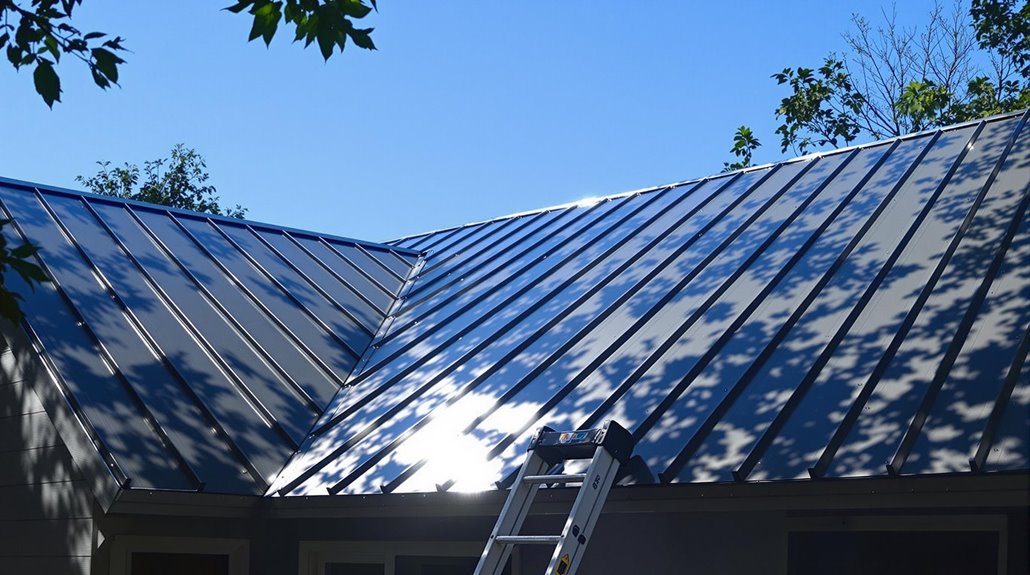
Installing a new roof represents one of the most significant investments homeowners can make to enhance their insurance coverage benefits and reduce long-term costs. Premium benefits can range from 5% to 35% reduction in insurance costs, particularly when installing impact-resistant or weather-resistant materials.
Coverage advantages extend beyond immediate cost savings. New roofs made with durable materials like metal or tile offer superior protection against severe weather events, reducing the likelihood of damage claims.
Insurance companies recognize this reduced risk through additional discounts for specific certifications and material choices. Fire-resistant and impact-resistant roofing materials can qualify homeowners for further premium reductions. Regular maintenance of a new roof, combined with proper documentation and certification, maximizes these insurance benefits while ensuring long-term protection for the property.
Homeowners in high-risk zones may see even greater insurance savings with a new roof, as these areas typically face up to 300% higher base premium rates.
Key Factors That Determine Roof-Related Insurance Premiums
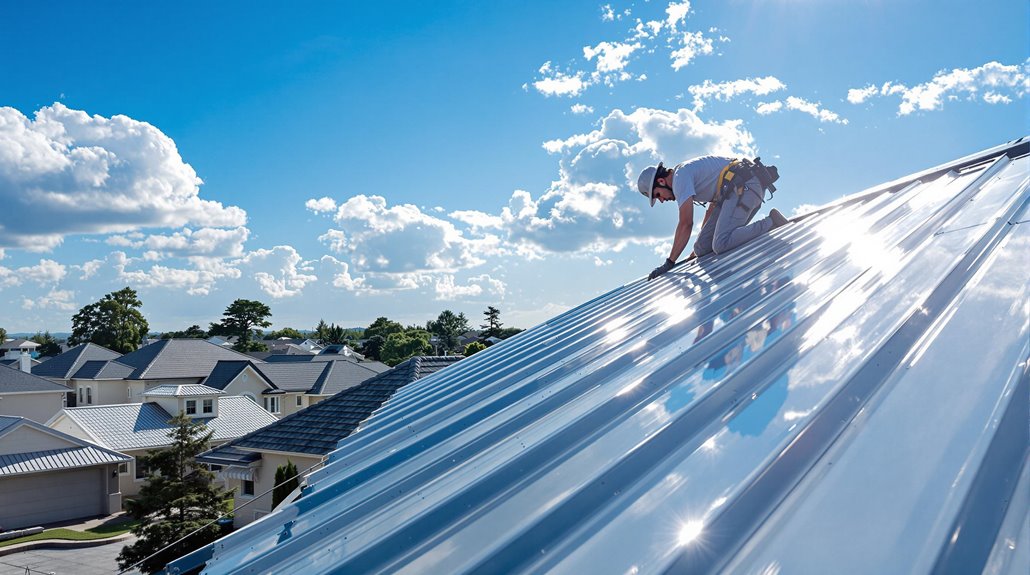
Insurance companies evaluate roof-related premiums based on the quality and durability of roofing materials, with premium-grade materials like metal and impact-resistant tiles typically qualifying for lower rates compared to standard asphalt shingles.
Geographic location plays a critical role in premium calculations, as insurers assess regional risks such as exposure to severe weather events, hailstorms, and natural disasters.
The combination of superior materials and location-specific risk factors can result in premium variations of 5% to 35%, with homes in high-risk areas requiring more robust roofing solutions to qualify for ideal coverage rates.
Hip roof designs offer superior wind resistance compared to gable roofs, which can significantly impact insurance premiums in storm-prone regions.
Material Quality Impact
Through careful consideration of roofing materials, homeowners can substantially influence their insurance premiums.
Material durability and installation craftsmanship play pivotal roles in determining coverage costs, with insurers favoring materials that demonstrate long-term reliability and resistance to environmental damage.
- Metal roofing systems, particularly those made from zinc, copper, or steel alloy, command lower premiums due to superior fire resistance and longevity
- Slate and tile materials offer premium reductions through their proven stability and durability
- Traditional asphalt shingles, while common, may lead to higher rates due to shorter lifespans
- Wood-based roofing materials typically result in elevated premiums due to fire susceptibility
Insurers assess both the material quality and its expected performance when calculating risk exposure, making material selection a critical factor in long-term insurance costs.
Professional installation from certified roofers can significantly reduce future leak-related claims and subsequent premium increases.
Location Risk Assessment
Beyond material considerations, geographic location represents a fundamental determinant in roof-related insurance calculations. Weather patterns and regional demographics substantially influence premium rates, with areas experiencing frequent hail, snow, or hurricanes typically facing higher costs.
Local building codes and proximity to natural hazards play essential roles in risk assessment. Properties in regions with strict construction standards often benefit from lower premiums, while those near trees, water bodies, or wildfire-prone areas may face increased rates.
Insurance companies analyze these geographic factors alongside market dynamics to determine appropriate coverage costs. Compliance with regional building standards and the implementation of location-specific protective measures, such as hurricane-rated materials, can help mitigate these location-based risks and potentially reduce insurance expenses. Working with public insurance adjusters can lead to 30-50% higher settlements when filing claims for location-specific roof damage.
When Insurance Will Pay for Your New Roof

Understanding when homeowners can expect insurance coverage for a new roof depends primarily on the cause and extent of damage.
Insurance companies typically provide coverage when the damage results from specific covered perils, such as storm damage, sudden leaks, or fallen trees. A claims adjuster must assess and verify the extent of damage before approving coverage.
- Documentation of damage through photos and videos
- Professional assessment by a claims adjuster
- Verification that damage resulted from covered perils
- Multiple repair estimates from qualified contractors
The type of insurance policy substantially impacts the payout amount. Replacement Cost Value policies cover the full cost of a new roof minus the deductible, while Actual Cash Value policies only provide the depreciated value.
Working with public insurance adjusters can increase claim settlements by up to 700% compared to handling the claim independently.
Homeowners should review their policy details to understand their coverage limitations and requirements for filing a successful claim.
Smart Strategies for Filing Roof Insurance Claims
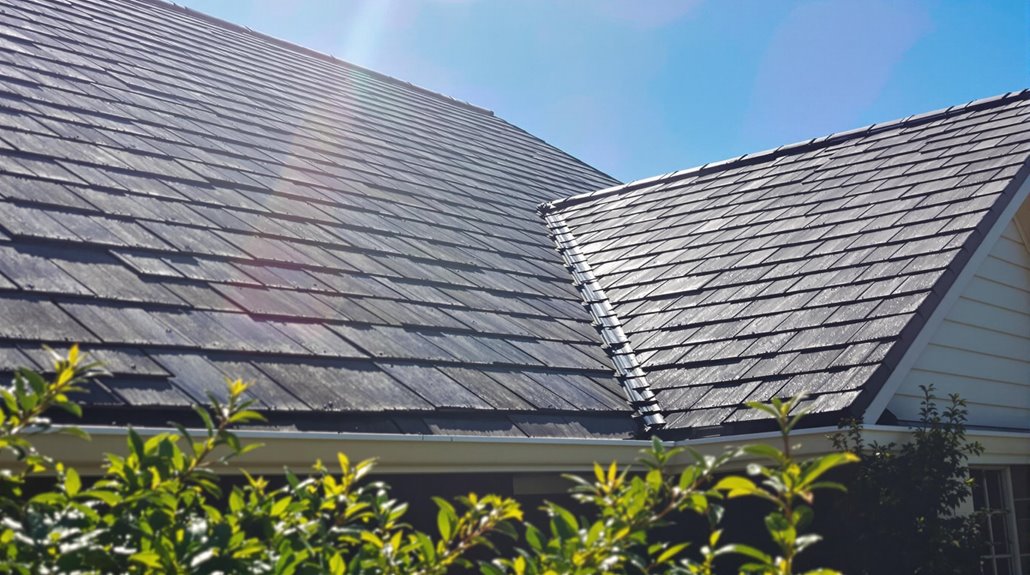
Successfully filing a roof insurance claim requires careful preparation and strategic execution to maximize the chances of approval. A thorough documentation strategy begins with thoroughly reviewing the insurance policy and understanding coverage limitations and deductibles.
The timing tactics of the claim process are critical. Homeowners should promptly document damage through photos and videos, obtain professional estimates, and notify their insurance carrier.
Having a trusted contractor present during the adjuster's inspection can guarantee all damage is properly identified. If disputes arise, policyholders should maintain detailed records and be prepared to provide additional evidence to support their claim. When necessary, professionals such as attorneys can assist in negotiating settlements with insurance companies to guarantee fair compensation for roof repairs or replacement.
Working with public insurance adjusters can increase claim settlements by 20-50% while handling all paperwork and negotiations with the insurance company.
How Different Roofing Materials Affect Insurance Costs
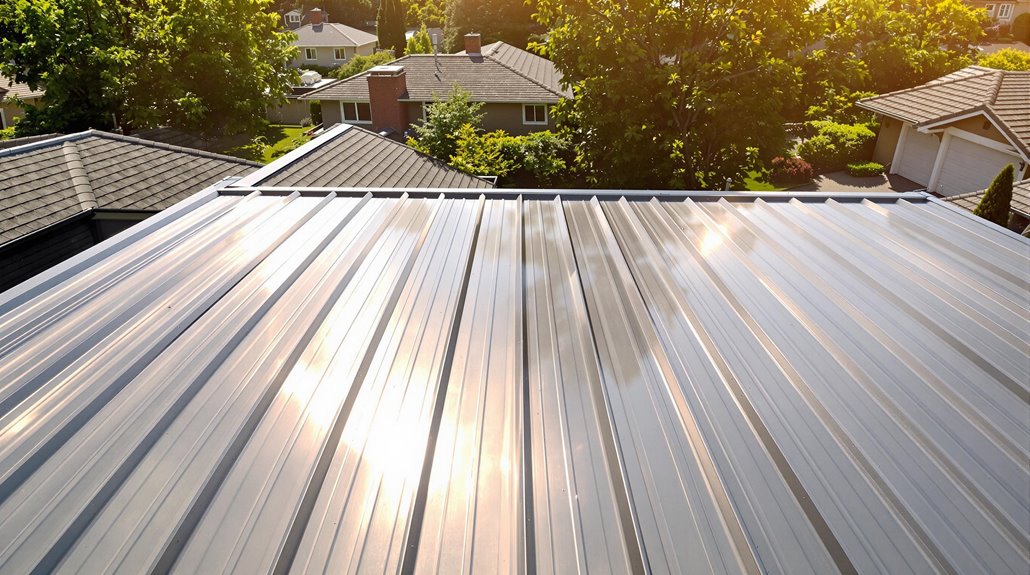
Different roofing materials can substantially impact insurance premiums, with metal roofs typically commanding the lowest rates due to their superior durability and fire resistance.
Insurance providers often consider the weather resistance capabilities of roofing materials when determining costs, ranking metal roofs highest, followed by slate and tile, with asphalt shingles generally resulting in moderate premium rates.
The enhanced longevity of premium materials like metal, which can last 40-70 years, translates into substantial long-term insurance savings compared to traditional asphalt shingles that require replacement every 15-30 years.
Metal roof restorations can provide 50-70% cost savings compared to complete replacements while maintaining optimal insurance premiums.
Premium Impact by Material
The selection of roofing materials can substantially influence homeowners' insurance premiums, with variations ranging from modest discounts to significant cost reductions.
Premium variations directly correlate with material durability and expected lifespan, as insurers assess risk based on these factors.
- Metal roofs, with a 50-year lifespan, typically qualify for the highest premium discounts due to superior durability and weather resistance
- Class 4 impact-resistant asphalt shingles earn substantial discounts for their ability to withstand severe weather conditions
- Tile roofing materials command favorable rates due to their exceptional durability and resistance to damage
- Standard asphalt shingles, with shorter lifespans around 15 years, generally result in higher premiums due to increased vulnerability
Insurance companies particularly value materials that demonstrate resistance to local weather hazards, offering enhanced coverage terms and reduced premiums for superior protection.
Working with public adjusters during roof-related claims can increase settlement amounts by 30-50% through expert policy interpretation and professional negotiation.
Durability and Cost Savings
From a cost-benefit perspective, roofing material selection directly influences both long-term durability and insurance premium savings. Materials like metal and slate demonstrate superior material durability, lasting 40-70 years and over 100 years respectively, which insurers recognize through reduced premiums.
While these materials require higher initial investments, they generate substantial replacement savings through lower maintenance requirements and decreased risk of damage.
Impact-resistant and weather-resistant materials qualify for specific insurance discounts, particularly when backed by certifications. Fire-resistant options like metal and slate further reduce insurance costs. The combination of extended lifespan and enhanced resistance to environmental factors makes premium materials particularly attractive to insurers, who factor these characteristics into their risk assessment and premium calculations. Working with public adjusters can increase insurance settlements by up to 50% when filing claims for roof replacement or damage.
Weather Resistance Rankings
Weather resistance capabilities of roofing materials play a pivotal role in determining insurance premiums, with superior materials offering enhanced protection against regional climate challenges.
Different materials exhibit varying levels of climate resilience, directly impacting both risk assessment and insurance costs.
- Metal roofs consistently rank highest for weather patterns in both hot and cold climates, offering superior protection against hail, snow loads, and heat reflection
- Slate roofs demonstrate exceptional durability across climate zones, particularly excelling in cold regions with heavy snow
- Concrete and clay tiles provide excellent thermal resistance in hot climates but require structural consideration due to weight
- Impact-resistant asphalt shingles offer moderate protection at an economical price point, though they may require more frequent replacement in extreme conditions
Getting the Best Insurance Rates After a Roof Replacement
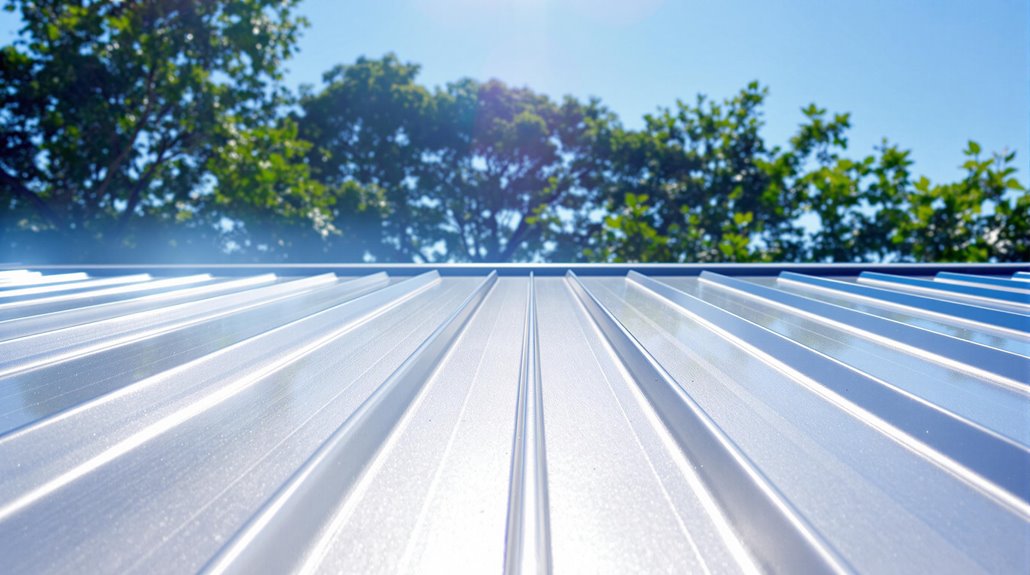
Smart homeowners looking to secure ideal insurance rates after a roof replacement must consider multiple factors that influence premium calculations. Material selection plays a vital role, with durable options like metal and slate typically qualifying for premium discounts compared to standard asphalt shingles. The installation of Secondary Water Resistance (SWR) can lead to additional savings.
Geographic location and local weather patterns substantially impact rates, particularly in areas prone to severe storms or hurricanes.
Professional installation by reputable contractors, combined with regular maintenance and inspections, demonstrates responsibility to insurers. Voluntary roof replacement often results in better rates than involuntary replacements due to damage.
To maximize benefits, homeowners should review their policies with insurance agents and guarantee compliance with local building codes while documenting all maintenance efforts.
The Benefits Of Consulting A Public Adjuster
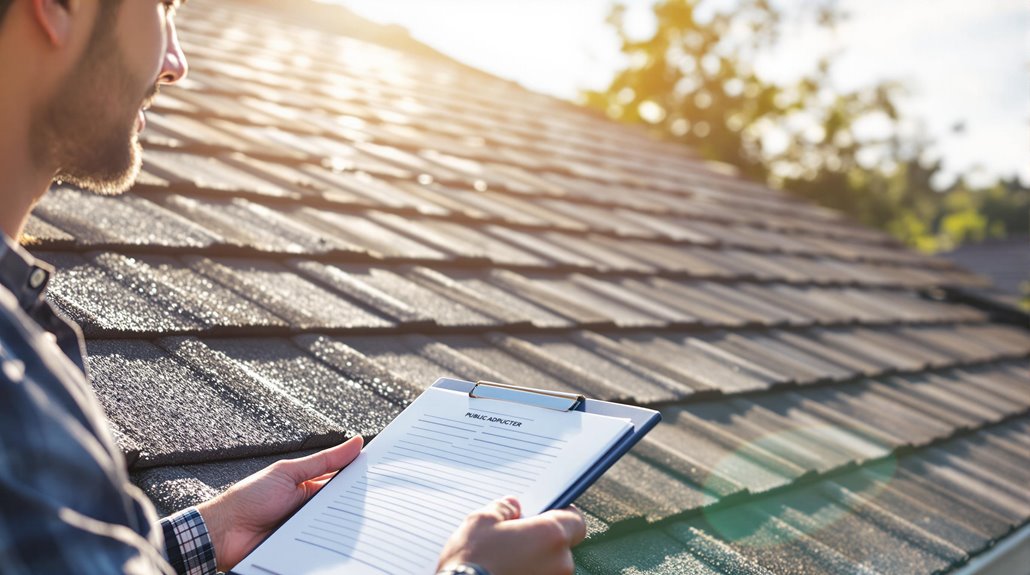
When maneuvering complex insurance claims for roof damage, homeowners can benefit substantially from consulting a public adjuster who brings expertise in policy interpretation and objective damage assessment.
The adjuster's professional guidance streamlines the claims process by managing documentation, communications, and negotiations with insurance companies while avoiding common pitfalls that could lead to claim denials.
Research indicates that public adjusters can secure settlements up to 747% higher than initial insurance offers through thorough damage evaluations and skilled negotiations with insurance providers.
Expertise In Insurance Claims
Insurance claims experts, known as public adjusters, offer invaluable expertise that can substantially impact the outcome of roof-related insurance claims.
Their policy navigation skills and technical mastery enable accurate interpretation of complex insurance documents, ensuring policyholders receive maximum entitled benefits while maintaining compliance with state regulations.
- Deep understanding of insurance policies and procedures, including fine print details and coverage limitations
- Professional documentation management, including damage assessments and thorough proof of loss preparation
- Strategic negotiation capabilities to counter insurance company tactics and secure fair settlements
- Efficient claims process management that saves time and reduces stress for policyholders
Public adjusters serve as dedicated advocates, handling intricate paperwork and negotiations while ensuring claims are presented accurately and thoroughly to insurance companies.
Their expertise often proves vital in maximizing settlement amounts and achieving favorable claim resolutions.
Objective Damage Assessment
Professional damage assessment from public adjusters delivers essential objectivity and thoroughness in evaluating roof-related insurance claims. Their expertise guarantees complete damage documentation through neutral evaluations and expert verification of both visible and concealed issues. Public adjusters employ specialized knowledge to prevent underestimation of damages and maintain detailed records of all findings.
| Assessment Component | Documentation Method | Impact on Claim |
|---|---|---|
| Visible Damage | Photographic Evidence | Primary Proof |
| Hidden Issues | Technical Reports | Future Protection |
| Structural Integrity | Expert Analysis | Safety Validation |
| Cost Estimation | Multiple Quotes | Fair Settlement |
| Repair Requirements | Detailed Specifications | Scope Definition |
Their systematic approach includes thorough inspections from multiple angles, detailed reporting of all affected areas, and professional validation of repair requirements, guaranteeing insurance companies receive accurate, well-documented claims for proper evaluation.
Streamlined Claim Process
Engaging a public adjuster substantially streamlines the insurance claims process for homeowners seeking roof-related settlements. Their expertise in efficient documentation and timely processing guarantees that claims move forward without unnecessary delays.
Public adjusters meticulously handle all paperwork, from damage assessments to repair estimates, while professionally negotiating with insurance companies on behalf of policyholders.
- Complete organization of essential documentation, including proof of loss and damage reports
- Professional interpretation of policy terms and conditions to maximize entitled benefits
- Strategic negotiation with insurance providers to secure fair settlements
- Effective management of regulatory compliance and procedural requirements
Their thorough understanding of insurance company strategies and claims procedures enables them to advocate effectively while saving homeowners valuable time and reducing stress during the settlement process. This professional support proves invaluable in achieving ideal claim outcomes.
Higher Claim Payouts & Settlements
While homeowners may initially hesitate at the cost, partnering with a public adjuster often leads to substantially higher insurance claim settlements that can offset their contingency fees. These licensed professionals conduct thorough Professional Reviews of property damage and create detailed Payment Analysis reports to maximize claim values.
Working exclusively for homeowners, public adjusters leverage their expertise to identify all compensable damages and negotiate effectively with insurance companies.
Their knowledge of policy terms, including RCV versus ACV coverage, enables them to pursue appropriate compensation levels. Operating on a contingency basis of up to 10% of the settlement, adjusters are incentivized to secure maximum payouts. Their ability to remove emotional bias from negotiations while understanding regional pricing variations and damage values typically results in more favorable settlement outcomes.
About The Public Claims Adjusters Network (PCAN)
The Public Claims Adjusters Network (PCAN) stands as a robust alliance of seasoned insurance claim professionals dedicated to guiding policyholders through complex claim processes.
Their Network Benefits encompass extensive claims handling solutions while maintaining Industry Standards through experienced adjusters who possess deep knowledge of insurance policies and procedures.
Key aspects of PCAN's professional services include:
- Expert assessment and interpretation of insurance policies for maximum coverage benefits
- Specialized handling of both routine and catastrophic claims
- Direct advocacy during settlement negotiations with insurance carriers
- Real-time tracking and management of claims throughout the entire process
PCAN's proven expertise guarantees fair settlements through accurate damage assessment, policy interpretation, and effective negotiation strategies, ultimately securing ideal outcomes for policyholders seeking assistance with insurance claims.
Frequently Asked Questions
Can I Transfer My Roof Warranty to a New Homeowner?
With 85% of roof warranties being transferable, homeowners can typically transfer their roof warranty to new owners through proper documentation requirements and warranty transfer procedures within 60 days of sale.
How Often Should I Schedule Professional Roof Inspections for Insurance Purposes?
Professional inspection schedules recommend annual assessments, with additional inspections after severe weather events. Bi-annual inspections in spring and fall provide maximum protection and guarantee compliance with insurance requirements.
Do Solar Panel Installations Affect My Roof Insurance Coverage?
Solar enhancements require adjustments to coverage limits, as installations impact homeowner policies. Insurance providers evaluate warranty transfers and may necessitate additional protection for complete panel and roof safeguarding.
Will Previous Roof Damage Claims Affect Future Insurance Rates?
Previous roof damage claim history typically results in premium increases, as insurers assess elevated risk levels. Multiple claims within short periods can substantially impact rates and future insurability.
Are DIY Roof Repairs Covered Under Standard Insurance Policies?
Like a safety net with holes, DIY roof repairs typically void insurance coverage due to warranty limitations and coverage exclusions. Standard policies require certified professional installation to maintain protection.
References
- https://www.cedur.com/how-much-will-a-new-roof-lower-my-homeowners-insurance
- https://www.robertsonryan.com/2024/10/30/new-roof-guidelines-for-insurance-what-you-need-to-know/
- https://www.billraganroofing.com/blog/will-insurance-pay-new-roof
- https://www.bogleheads.org/forum/viewtopic.php?t=348107
- https://rapidroofing.com/blog/do-you-need-to-tell-insurance-about-new-roof-maximizing-benefits-coverage-mi-oh/
- https://blueangelsroofing.com/how-does-getting-a-new-roof-affect-my-home-insurance/
- https://www.alfainsurance.com/news-and-insights/roof-factors-that-can-affect-your-insurance
- https://www.angi.com/articles/will-a-new-roof-lower-insurance.htm
- https://www.progressive.com/answers/does-home-insurance-cover-roof-damage/
- https://www.nationwide.com/lc/resources/home/articles/limited-roof-replacement




